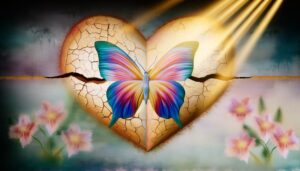What Does a Dead Bird Symbolize in Art and Literature?
The symbol of a dead bird holds significant cultural, artistic, and psychological meanings. Historically, it represented omens, mortality, and the transience of life, as observed in Ancient Egyptian and Greek societies.
Taxonomically, species like *Corvus corax* and *Turdus migratorius* are often used in art and literature to symbolize environmental degradation and human impact. Native American cultures viewed dead birds as integral to the life-death cycle.
Modern interpretations in multimedia art forms highlight themes of ecological fragility and societal neglect. The detailed study of these symbols reveals the intricate interplay between human psyche and natural ecosystems.
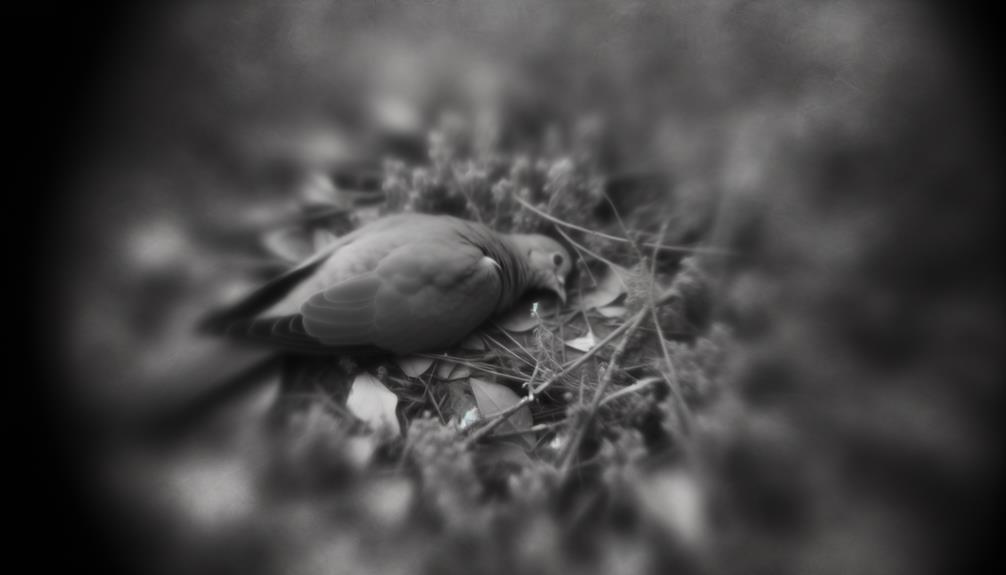
Key Takeaways
- Dead birds in literature symbolize mortality, loss of innocence, and broken dreams.
- In art, dead birds represent themes of mortality, environmental degradation, and human impact on nature.
- Folklore often views dead birds as omens of change or messages from the beyond.
- Ancient civilizations used dead birds as symbols of omens, mortality, and the transience of life.
- Contemporary artists use dead birds to comment on ecological fragility and societal neglect.
Historical Context
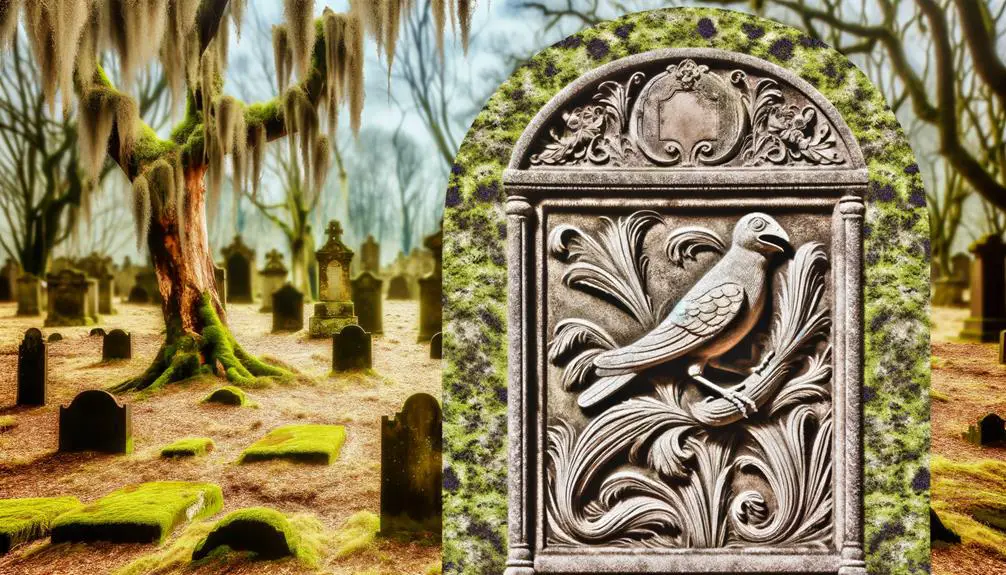
In the field of ornithological symbolism, the historical context of the dead bird motif can be traced back to ancient civilizations. It often represented omens, mortality, and the transience of life. For instance, the Ancient Egyptians, who held the sacred ibis (Threskiornis aethiopicus) in high regard, interpreted the death of birds as a signifier of impending doom.
Similarly, Greek mythology frequently employed avian symbolism, with the death of the nightingale (Luscinia megarhynchos) emblematic of sorrow and loss. Archaeological findings indicate that Native American cultures also imbued the image of a dead bird with spiritual significance, associating it with the cycle of life and death. Such interpretations highlight the deep-rooted, cross-cultural resonance of this motif.
Literary Interpretations
Exploring the domain of literature, the motif of the dead bird emerges as a profound symbol, often employed to evoke themes of existential despair, impermanence, and the fragility of life. This poignant imagery can be systematically dissected through various taxonomic references and detailed observations.
In literary works, the dead bird's symbolism is multifaceted, often representing:
- Mortality: Highlighting the inevitable end that all living beings face.
- Loss of Innocence: Signifying the end of purity and the onset of harsh realities.
- Broken Dreams: Reflecting unattained aspirations and unfulfilled potential.
- Environmental Degradation: Serving as a metaphor for ecological harm.
- Isolation: Illustrating detachment from the natural world and community.
Such interpretations underscore the literary depth and universal relevance of the dead bird symbol.
Artistic Representations
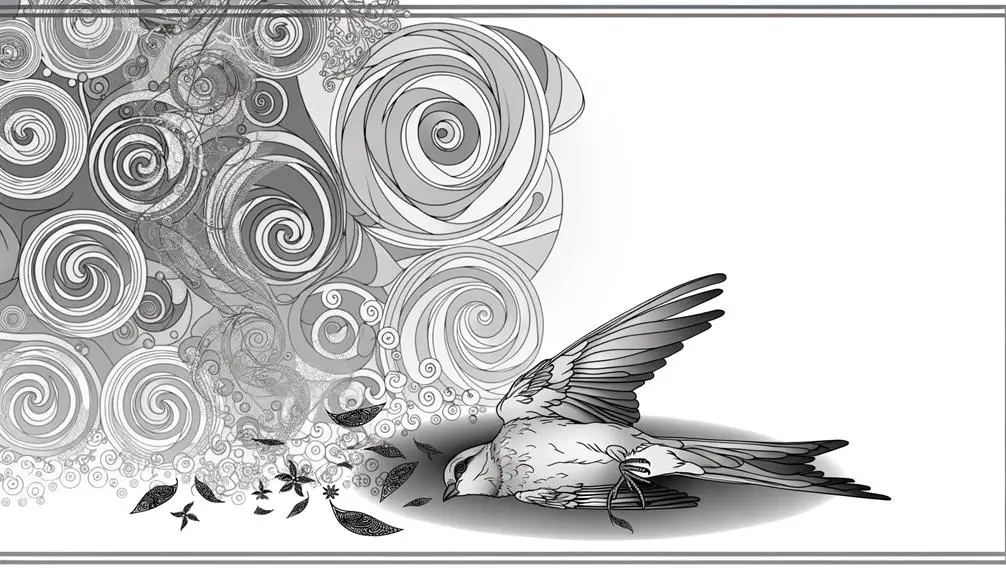
The artistic representations of dead birds, spanning historical periods, offer a rich tapestry of visual and symbolic analysis, with notable examples in classical still life (e.g., *Vanitas* paintings) and modern installations. Such depictions often encapsulate cultural symbolism, varying from omens of mortality to reflections on the transient nature of life.
Contemporary artists reinterpret these themes, incorporating taxonomic references and ecological concerns, connecting traditional iconography with modern socio-environmental discourses.
Historical Art Depictions
How have artists across various historical periods and cultures depicted the symbol of a dead bird in their works, often employing intricate iconography and symbolism to convey themes of mortality, transformation, and the natural cycle?
Through the ages, this motif has been meticulously illustrated to evoke profound reflections on life's ephemeral nature.
- Renaissance Art: Artists like Caravaggio incorporated dead birds to signal human frailty.
- Baroque Period: Vanitas still lifes often featured dead birds, symbolizing the transient quality of earthly pleasures.
- Japanese Ukiyo-e: Prints by Hiroshige depicted the dead bird as a memento mori, reflecting Buddhist beliefs on impermanence.
- Victorian Era: Taxidermy and illustrated works used dead birds to explore natural history and mortality.
- Modern Art: Contemporary artists like Damien Hirst have employed dead birds in mixed media to discuss environmental degradation.
Cultural Symbolism Explored
Delving into the cultural symbolism of dead birds in artistic representations, one observes a rich tapestry of meanings that transcend mere mortality, encompassing ecological, spiritual, and societal dimensions.
Taxonomically, species such as Corvus corax (common raven) and Turdus migratorius (American robin) are frequently depicted, each species bearing distinct symbolic weight. For instance, a dead Corvus corax often signifies omens or the cessation of knowledge, reflecting its historical association with wisdom and foresight.
Conversely, the depiction of a deceased Turdus migratorius may evoke themes of lost innocence or disrupted natural cycles. Detailed observations reveal that artists employ these avian symbols to comment on human impact on ecosystems, invoking broader reflections on life, death, and the interconnectedness of all beings.
Modern Artistic Interpretations
In contemporary art, representations of deceased avian species such as Passer domesticus (house sparrow) and Falco peregrinus (peregrine falcon) are employed to elucidate themes of environmental degradation and existential reflection. Artists utilize these symbols to draw attention to the fragility of ecosystems and the impact of anthropogenic activities.
The juxtaposition of these taxonomic entities in various artistic media offers a poignant commentary on biodiversity loss and the human condition.
- Multimedia Installations: Integrate biological specimens with digital projections to highlight habitat destruction.
- Sculptural Works: Use found objects to recreate avian forms, emphasizing recycling and waste.
- Photographic Series: Capture decaying birds in urban settings, symbolizing neglect and apathy.
- Painting and Illustration: Employ detailed anatomical studies to evoke empathy and awareness.
- Performance Art: Enact rituals or reenactments to symbolize mourning and remembrance.
Cultural Significance
The cultural importance of a deceased bird, especially within historical symbolism and artistic interpretations, encompasses a myriad of taxonomic and societal aspects.
Historically, avian mortality has been depicted as a symbol of different omens, changes, and existential contemplations across various civilizations, from ancient Egyptian iconography to Victorian-era memento mori.
Artistic depictions frequently utilize particular species, like *Corvus corax* (common raven) or *Passer domesticus* (house sparrow), to evoke motifs of mortality, spiritual ascension, and the fleeting nature of life.
Historical Symbolism
Throughout various cultures and historical periods, the imagery of a deceased bird has been imbued with profound symbolic meanings, often reflecting themes of mortality, transformation, and the transient nature of life.
Historically, these avian symbols have been depicted in literature, folklore, and religious contexts, each carrying nuanced interpretations.
For example, in Ancient Egypt, deceased birds were seen as metaphors for the soul's journey to the afterlife, while Native American tribes considered them omens or messages from the spiritual domain.
In medieval European art, the deceased bird often symbolized the fragility of earthly existence.
Chinese mythology, on the other hand, views deceased birds as symbols of transformation and rebirth, reflecting a cyclical view of life and death.
In Victorian England, the imagery of a deceased bird was often associated with themes of mourning and loss, reflecting the prevailing attitudes towards death and grief in that era.
Artistic Interpretations
Artistic interpretations of deceased birds often encapsulate complex cultural narratives and symbolic taxonomies, reflecting varied societal beliefs and artistic traditions.
For instance, the portrayal of a dead Corvus corax (common raven) in art can signify omens or the transience of life, rooted in both Western and Eastern mythologies.
Detailed observations reveal that avian mortality in art frequently embodies themes of loss, change, and cyclicality.
The taxonomic diversity, from Passeriformes to Accipitridae, further enriches the symbolic lexicon, each species contributing distinct connotations—sparrows (Passeridae) might denote innocence lost, while eagles (Accipitridae) could invoke the fall of power.
This way, avian mortality in artistic traditions serves as a profound commentary on human existential experiences and cultural ethos.
Symbolism in Folklore
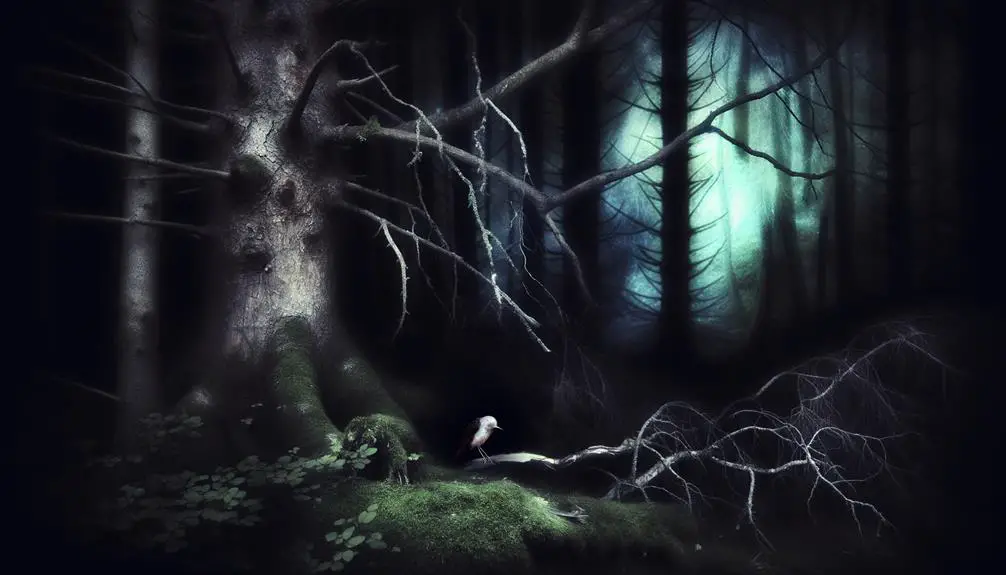
In various cultural narratives, the symbolism of a deceased bird often signifies omens, shifts, or messages from the spiritual domain. These interpretations can vary significantly across different folklore traditions, each embedding unique meanings into the avian imagery.
Taxonomically, birds belong to the class Aves, and their representations in folklore are both diverse and profound. Here are notable symbolic interpretations:
- Omens of Change: Dead birds often signal looming transformations or shifts.
- Harbingers of Death: In some cultures, a dead bird is a portent of impending mortality.
- Messages from Beyond: Birds, in their deceased form, may symbolize spirits attempting communication.
- Loss of Freedom: The death of a bird can metaphorically represent the cessation of liberty.
- Cycle of Life: It may also denote the natural progression and cyclical nature of existence.
Each interpretation offers a window into the cultural psyche and spiritual beliefs surrounding avian symbolism.
Themes of Loss
In examining the themes of loss, the mourning and grief processes elicited by the symbol of a deceased avian specimen, particularly within the Aves class, warrant detailed exploration.
Observations indicate significant emotional impact on individuals, often manifesting through psychological responses such as despair, nostalgia, and melancholia.
These responses are essential for understanding the broader implications of avian symbolism in cultural contexts.
Mourning and Grief Process
The mourning and grief process, following the loss of a significant entity as symbolized by a dead bird, involves a complex interplay of psychological, physiological, and social responses. This multifaceted experience can encompass various stages and manifestations, each unique to the individual and their relationship to the loss.
Observations in thanatology and bereavement studies indicate several identifiable reactions:
- Shock and Denial: Initial disbelief and refusal to accept the loss.
- Anger: Feelings of frustration or helplessness.
- Bargaining: Attempting to negotiate or find meaning in the loss.
- Depression: Profound sadness and withdrawal from usual activities.
- Acceptance: Gradual acknowledgment and integration of the loss into one's life.
Understanding these stages provides a framework for comprehending the intricate nature of grief.
Emotional Impact on Individuals
How does the symbol of a dead bird catalyze profound emotional responses in individuals, triggering themes of loss that resonate deeply within the human psyche? The dead bird, a representation of cessation of life, evokes profound emotional turmoil. This symbol can manifest feelings of sorrow, nostalgia, and existential reflection. Such responses are deeply rooted in the human experience of loss, reflecting our intrinsic connection to life and death. Observations in avian ethology (Aves: Passeriformes) indicate that the sight of a deceased bird can provoke empathy and recognition of mortality.
| Emotional Response | Psychological Impact | Behavioral Manifestation |
|---|---|---|
| Sorrow | Increased sadness | Withdrawal, Crying |
| Nostalgia | Reflective longing | Reminiscing, Sentimentalism |
| Existential Reflection | Awareness of mortality | Pondering life's meaning |
Understanding these reactions offers insight into the human condition and our relationship with nature.
Transformation and Rebirth
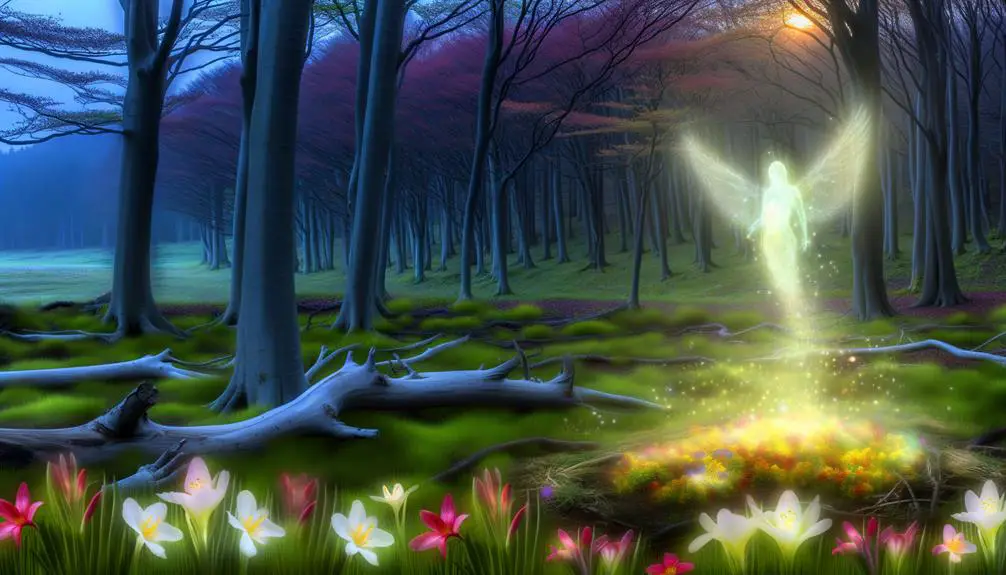
Change and rebirth, often symbolized by the imagery of a deceased bird, encapsulate the profound biological processes of metamorphosis and regeneration observed across various taxa. Within Aves, these processes can be seen in the molting cycles, wherein old feathers are shed to make way for new plumage, signifying renewal.
Similarly, amphibians like Anura undergo metamorphosis from larval tadpoles to adult frogs, representing significant physiological changes.
- Molting in Aves: Renewal of plumage.
- Anura metamorphosis: Shift from tadpole to frog.
Regeneration in Echinoderms, where sea stars regrow lost limbs, and insect metamorphosis, where caterpillars evolve into butterflies, are also fascinating examples of transformative processes in the animal kingdom. Additionally, the reproductive cycles in Mammalia, including seasonal breeding and birthing cycles, demonstrate the cyclical nature of life.
- Regeneration in Echinoderms: Sea stars regrow lost limbs.
- Insect metamorphosis: Caterpillars evolve into butterflies.
- Reproductive cycles in Mammalia: Seasonal breeding and birthing cycles.
These examples highlight the continuity and resilience inherent in natural systems.
Psychological Impact
Psychologically, the symbol of a deceased bird often evokes profound responses, encapsulating themes of loss, renewal, and the cyclical nature of existence.
Observationally, the deceased bird, often represented by species such as Passer domesticus (house sparrow) or Turdus merula (common blackbird), triggers an affective response linked to Thanatophobia—the fear of death.
This symbolic representation acts as a memento mori, prompting introspection on mortality and existential continuity.
Additionally, the demise of an avian creature, which is taxonomically associated with freedom and transcendence, juxtaposes notions of entrapment and finality.
Cognitive dissonance arises when the inherent energy of Aves is contrasted with their inert state, invoking a spectrum of emotional states from sorrow to philosophical contemplation on the ephemeral nature of life.
Modern Depictions
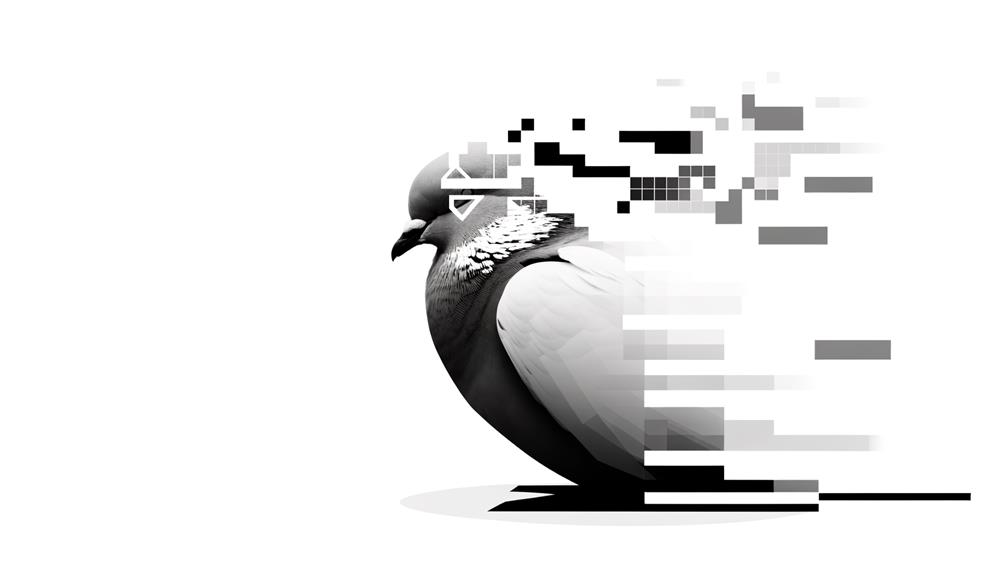
In contemporary art and media, the depiction of a dead bird often employs species-specific characteristics, such as the distinctive iridescence of *Sturnus vulgaris* (common starling) or the vibrant plumage of *Cyanocitta cristata* (blue jay), to evoke symbolic narratives of mortality and impermanence. These visual elements serve to:
- Highlight ecological concerns and biodiversity loss.
- Address themes of human impact on wildlife.
- Reflect on the transient nature of beauty and life.
- Invoke cultural and historical symbolism related to specific bird species.
- Create visual metaphors for personal and collective grief.
Through detailed and taxonomic precision, these depictions underscore the fragility of life, utilizing ornithological accuracy to enhance the thematic depth and resonance of their artistic and narrative intentions.
Personal Reflections
Observing a deceased *Turdus migratorius* (American robin) within one's daily environment often elicits a profound introspection on the interconnectedness of life and death. This avian species, notable for its migratory patterns and ecological significance, becomes a poignant symbol when lifeless. The encounter prompts reflections on mortality, ecological balance, and the cyclical nature of existence.
| Observation | Reflection |
|---|---|
| Deceased *Turdus migratorius* | Reminder of life's fragility |
| Ecological Role | Importance of each species in the ecosystem |
| Migratory Patterns | The impermanence and transience of life |
| Symbolism | Connection between natural cycles and human life |
Such experiences can deepen one's appreciation for biodiversity and underscore the intricate web of life that sustains our planet.
Conclusion
In sum, the symbol of a deceased bird demonstrates various dimensions across historical, literary, and cultural contexts. Artistic allegories and folklore frequently feature the fallen feathered figure, illustrating themes of transformation and transcendence.
The psychological poignancy and symbolic potency persist in modern portrayals, perpetuating its profound presence. The emblematic essence of the expired avian entity elucidates existential inquiries, embodying both demise and rejuvenation.
Such symbolic significance continues to captivate and compel thorough contemplation.





